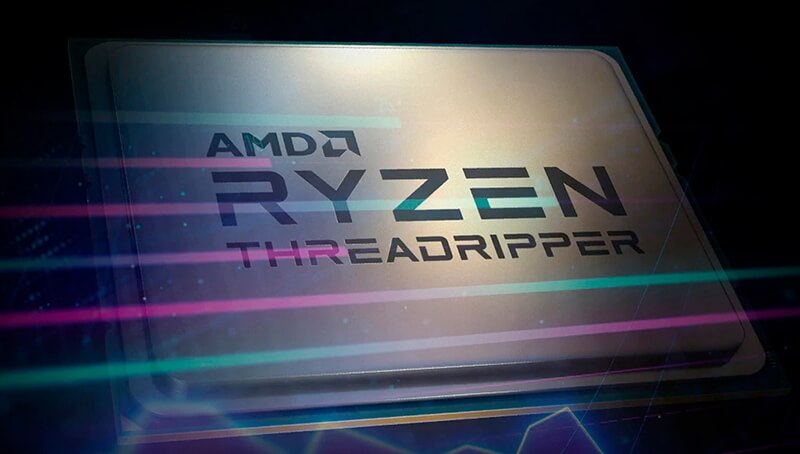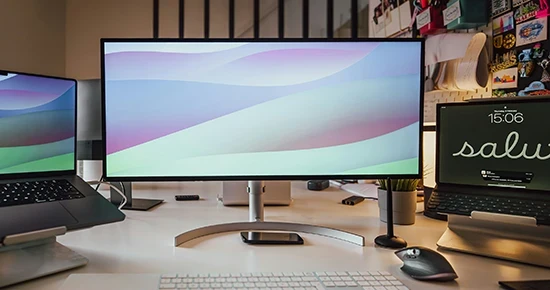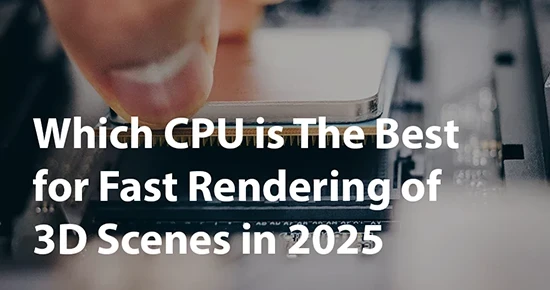The Best CPU for Rendering
Most modern processors can handle almost any workload given enough time. However, faster processors with more cores and/or higher clock speeds can tackle heavy workloads in significantly less time, making them excellent choices for boosting productivity.
A processor that performs exceptionally well in gaming might not necessarily be the best for rendering if that's your primary workload. In fact, as high-core-count processors become more common, gaming CPUs and workstation CPUs are becoming increasingly distinct silicon creatures, making it challenging to determine which processor is best suited for your rendering tasks. Therefore, we have compiled a list of top processors that offer the best value for rendering speed.
How to choose the best processor for rendering:
- Always go for the latest generation. You won't save much by opting for an older chip, and it may limit your upgrade possibilities in the future.
- Consider the motherboard. The most expensive processors require pricier motherboards compared to more affordable chips.
- Both high core counts and high clock speeds enhance rendering speed. Having more cores is typically the best cost-to-performance ratio for increasing the speed of 3D rendering processors.
- However, rendering is not the only task typically performed on a typical computer. If you actively work on tasks such as 3D modeling, photo editing, graphic design, or video editing, having higher clock speeds will bring you much more benefit than having a higher core count. This means it would be better to have both a high core count and high core clock speeds. Since central processors usually trade off cores for clock speeds (due to thermal limitations and power regulations), you typically have to find a balance between core count and clock speed.
Best processors for rendering:

AMD Threadripper PRO 3995WX
The best processor for any task
Core Architecture: Zen | Socket: sTRX4 | Cores/Threads: 64/128 | Base Frequency: 2.7GHz | Max Frequency: Up to 4.2GHz | Cache Memory (L1/L2/L3): 4/32/256MB | Unlocked: Yes | Max Temperature: 95°C
The 64 cores of the processor provide incredible computational power to support 128 threads simultaneously, and the cache memory with a total capacity of 288MB, along with the massive I/O bandwidth on the AMD TRX40 platform, designed for a wide range of computer enthusiasts, delivers incredible performance.
Ryzen™ Threadripper™ processors allow you to combine up to six NVMe drives for achieving the highest speed and reliability. Want to further expand your capabilities? Get double the bandwidth with the PCIe® 4.0 interface, specifically designed for high-tech desktop PCs based on AMD TRX40 motherboards.

AMD Ryzen 9 5950X
Best value for money
Core Architecture: Zen | Socket: AM4 | Cores/Threads: 16/32 | Base Frequency: 3.4GHz | Max Frequency: Up to 4.9GHz | Cache Memory (L1/L2/L3): 1/8/64MB | Unlocked: Yes | TDP: 105W
The AMD Ryzen 9 5950X is a beast, the best chip available on mainstream consumer platforms with sixteen cores. And since Ryzen chips are multi-threaded, it means the 5950X can handle thirty-two parallel threads.
The sixteen-core Ryzen 9 5950X also outperforms Intel. It's twice as many cores as any Intel Core i7 chip. It also doubles the number of cores available on Intel Coffee Lake-based Core i9 components, although Intel Core i9-10 processors will have 10 to 18 cores.
The Ryzen chip has base and boost clock speeds of 3.4GHz and 4.9GHz, respectively. This is solid power, especially for a chip packed with cores—the former being an average figure for the AMD range, but this turbo speed is the best available on AMD Ryzen. Thus, with this processor, you get a tremendous amount of powerful cores, which is crucial for demanding workloads such as content creation, 3D modeling, rendering, and CAD.

Intel Core i9-11900K
Basic rendering processor from Intel
Core Architecture: Rocket Lake-S | Socket: LGA1200 | Cores/Threads: 8/16 | Base Frequency: 3.5GHz | Max Frequency: Up to 5.3GHz | Cache Memory: 16MB | Unlocked: Yes | TDP: 125W
If you're looking to upgrade your PC in 2021, the best option would be the AMD Ryzen 9 5900X or the 5950X, although it is slightly more expensive. For the same money, the 5900X delivers significantly better performance while consuming less power compared to Intel's flagship offering. AMD is leading the pack with its current Ryzen 9 series, and it's honestly an unfair comparison between AMD and Intel, even though they are priced similarly.
However, if you prefer to stick with Intel and want to utilize their processors, the Core i9-11900K is a great option in 2021. The Rocket Lake-S chip is just as fast as the more expensive Intel models for multi-threaded scenarios, whether it be 3D modeling or rendering.

AMD Ryzen 7 3700X
Basic rendering processor from AMD
Core Architecture: Zen | Socket: AM4 | Cores/Threads: 8/16 | Base Frequency: 3.6GHz | Max Frequency: Up to 4.4GHz | Cache Memory: 512KB/4/32MB | Unlocked: Yes | Max Temperature: 95°C
AMD continues to offer as many options as possible, earning recognition from the enthusiast community. They also remain true to their standard of providing more for less money. The Ryzen 7 3700X comes with a powerful cooler that can even provide some overclocking headroom.
AMD also continues to offer fully unlocked processors for all Ryzen models and allows overclocking on motherboards. This has been a sore point for enthusiasts who had to pay more for overclocking features with Intel. AMD is even expanding on this with the introduction of Precision Boost Overdrive and AutoOC features, which provide overclocking for regular users with just a few mouse clicks in their user-friendly Ryzen Master utility. Intel still holds the crown for overclocking, but it's becoming a diminishing advantage against processors with twice the cores at more competitive prices.
The eight-core, 16-thread Ryzen 7 3700X offers incredible energy efficiency combined with high rendering speeds. The fully unlocked processor also supports PCIe 4.0 interface and comes with a powerful Wraith Spire RGB cooler. Value seekers among us will also appreciate the backward compatibility with X470 motherboards.
Comparison of Intel vs AMD processors
AMD Ryzen, Threadripper, Intel i5, i7, i9, XEON, Pentium, some with high core counts, others with high core frequencies.
In the end, it all comes down to the raw CPU rendering performance, which we measured using Cinebench R15, the leading software for CPU rendering performance testing. The table also includes the number and power of cores, approximate cost of each processor, and their Performance/Dollar ratio.

Processor designations:
What is Ryzen?
Ryzen is the latest generation of processors from AMD. The Ryzen 5 and Ryzen 7 processors are targeted towards different segments of users, but both series provide real power for gaming, multimedia content creation, and professional-level tasks (such as graphic design, CAD, etc.). Consumer demands for hardware are constantly increasing, so they are looking for processors that will give them the capabilities to handle diverse tasks, often simultaneously.
What is Threadripper?
Threadripper is the first-ever 64-core processor designed for use in high-performance desktop systems. Until recently, offerings with such a high core count existed only in the server segment, but now AMD has decided to level the playing field for servers and workstations, offering both markets roughly the same capabilities but in slightly different packaging. In fact, the Threadripper 3990X is an HEDT (High-End Desktop) equivalent of the Rome-generation EPYC 7702P, but with four instead of eight memory channels, half the number of supported PCI Express lanes, removed server security features, but with extended TDP ranges and increased clock speeds.

Two Monitors Or One Ultra Wide Monitor: Which Is Better?
Building the Ultimate Computer for SketchUp Work
Which CPU is The Best for Fast Rendering of 3D Scenes in 2025
5 Best GPUs for Graphic Design Professionals
The Best Laptop for 3D Modeling and Rendering in 3ds Max
Choosing a Computer for GPU Rendering

Latest Discussions
Woowww it s look awsome
This is simply amazing. I am in love with this atmosphere.
Thank you so much!! 
Beautifully composed scene! The sense of depth and lighting are just perfect. ✨
Harika bir sahne kurgusu! Derinlik ve ışık kullanımı mükemmel. ✨















Woowww it s look awsome